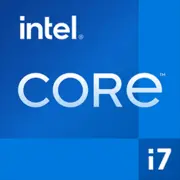Intel Core i7-1270P

Intel Core i7-1270P: A Powerful Hybrid for Thin Laptops — Review and Recommendations
(March 2025)
Modern laptops require a balance between performance, battery life, and compactness. The Intel Core i7-1270P, part of the Alder Lake lineup introduced in 2022, remains a relevant solution for ultrabooks and business devices. Let's explore what sets it apart and who it is suited for in 2025.
Architecture and Process Technology: A Hybrid Approach and Intel 7
The Core i7-1270P processor is built on the Alder Lake hybrid architecture, which combines high-performance (P-Cores) and energy-efficient (E-Cores) cores.
- Cores and Threads: 12 cores (4 P-Cores + 8 E-Cores) and 16 threads. P-Cores handle heavy tasks (rendering, gaming), while E-Cores manage background processes (updates, streaming).
- Clock Speeds: Base frequency for P-Cores is 2.2 GHz, and the maximum in turbo mode is 4.8 GHz. E-Cores operate at frequencies up to 3.5 GHz.
- Cache: 18 MB of L3 cache, which speeds up data processing in multi-threaded scenarios.
- Process Technology: Intel 7 (10 nm Enhanced SuperFin) — improved energy efficiency compared to previous generations.
- iGPU: Integrated Intel Iris Xe graphics (96 EU) supports 4K displays, light gaming (e.g., Dota 2 at medium settings), and hardware acceleration in programs like Adobe Premiere.
Why it matters? The hybrid architecture allows for task distribution between cores, reducing power consumption without sacrificing speed. For instance, when working in Chrome, P-Cores are loaded only when opening "heavy" tabs, while E-Cores manage background processes.
Power Consumption and TDP: A Balance Between Power and Heat
The processor's nominal TDP is 28 W, but during turbo mode, power can briefly spike to 64 W. This is typical for P-series processors aimed at thin laptops with active cooling.
- Thermal Output: In compact chassis (e.g., Dell XPS 13), under load, temperatures can reach 85–90°C, but throttling (frequency reduction) begins only under prolonged load.
- Cooling: For stable performance in gaming or rendering, a system with two fans and copper heat pipes is needed. In ultrabooks (ASUS ZenBook 14), fan noise becomes noticeable when running Photoshop.
Tip: When purchasing, check reviews of the cooling system for the specific model. For instance, the Lenovo ThinkPad X1 Carbon (2023) with the i7-1270P demonstrates stable performance thanks to its optimized design.
Performance: Real-World Tasks and Turbo Mode
According to Geekbench 6, the i7-1270P scores 2032 in single-core and 7732 in multi-core tests. This is 15% higher than the i7-1165G7 (Tiger Lake), but lower than the Apple M2 (≈2400/8900).
Office Work and Multimedia
- Microsoft Office, Browsers: No delays even with 20+ tabs open.
- Photo Editing (Lightroom): Exporting 100 RAW photos takes ~3 minutes.
- Video Editing (Premiere Pro): Rendering a 5-minute 4K video takes about 8–10 minutes using Iris Xe.
Gaming
- Light Projects: CS:GO — 90–110 FPS at medium settings (1080p), Fortnite — 50–60 FPS (Low).
- Heavy Games: Cyberpunk 2077 — 25–30 FPS (Low, 720p), which is acceptable only for emergencies.
Turbo Boost Mode: When plugged in, the processor maintains P-Core frequencies at 4.5–4.8 GHz for up to 30 seconds, speeding up application launches. However, in battery mode, turbo mode is limited to save power.
Use Cases: Who is the i7-1270P For?
1. Office Workers and Students — multitasking, document work, and video conferencing.
2. Creative Professionals — video editing, 3D modeling (in conjunction with discrete graphics, e.g., NVIDIA RTX 3050).
3. Casual Gamers — light gaming and streaming.
Example: The HP Spectre x360 14 with i7-1270P and OLED display (price in 2025 starting at $1100) is ideal for designers.
Battery Life: How Long Does the Laptop Last?
With a TDP of 28 W, battery life depends on battery capacity:
- A laptop with a 60 Wh battery: 6–8 hours while working on documents (brightness at 50%, Wi-Fi on).
- Under load (gaming, rendering): 1.5–2 hours.
Power-Saving Technologies:
- Intel Dynamic Tuning — automatically reduces frequencies during light tasks.
- Adaptix — optimizes core performance in real time.
Tip: To increase battery life, choose models with a battery of at least 70 Wh, such as the Acer Swift 5 (up to 10 hours in office mode).
Comparison with Competitors
- AMD Ryzen 7 7840U (Zen 4): Better in multi-threaded tasks (Geekbench Multi ≈8500) and battery life, but weaker in single-thread performance. Laptop prices are comparable ($1200–$1400).
- Apple M2: 20% faster in creative tasks and lasts up to 18 hours, but has limited compatibility with Windows software.
- Intel Core i7-1370P (Raptor Lake): 10–12% performance increase, but at a higher price ($1300+).
Conclusion: The i7-1270P is a compromise for those who prioritize compatibility with the Windows ecosystem and versatility.
Pros and Cons of the Core i7-1270P
Strengths:
- High single-core performance for office and creative tasks.
- Support for Thunderbolt 4 and Wi-Fi 6E.
- Affordable laptop prices (from $900 in 2025).
Weaknesses:
- Heating under load in thin chassis.
- Battery life lags behind Apple M2/M3.
Laptop Selection Recommendations
- Ultrabooks: Pay attention to weight (up to 1.3 kg) and display (IPS or OLED). Example: ASUS ZenBook 14 ($999).
- Workstations: Look for models with discrete graphics (NVIDIA RTX 3050) and 32 GB RAM. For instance, MSI Prestige 16 ($1499).
- What to Check:
- Cooling system (preferably two fans).
- Ports (minimum 2 USB-C with Thunderbolt 4).
- Battery of at least 60 Wh.
Final Verdict
The Intel Core i7-1270P in 2025 is a solid choice for those who need a versatile laptop with good performance and support for Windows applications. It is suitable for:
- Office Users who value speed and multitasking.
- Designers and Editors working on "light" projects.
- Students looking for a balance between price and power.
Key Benefits: Hybrid architecture, support for modern interfaces, and optimal pricing. However, if maximum efficiency and battery life are critical, consider the Apple M3 or AMD Ryzen 7 8840U.
Basic
CPU Specifications
Memory Specifications
GPU Specifications
Miscellaneous
Benchmarks
Compared to Other CPU
Share in social media
Or Link To Us
<a href="https://cputronic.com/en/cpu/intel-core-i7-1270p" target="_blank">Intel Core i7-1270P</a>